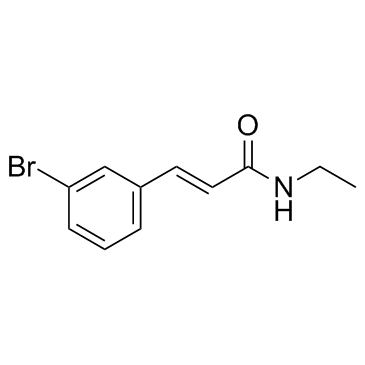Cinromide (trans-3-Bromo-N-ethylcinnamamide) |
| Catalog No.GC30868 |
Cinromide (trans-3-Bromo-N-ethylcinnamamide) is an anticonvulsant agent.
Products are for research use only. Not for human use. We do not sell to patients.

Cas No.: 58473-74-8
Sample solution is provided at 25 µL, 10mM.
Cinromide is a broad-spectrum anticonvulsant agent.
Cinromide (10-100 μM) inhibits 5-HT-induced contractions in rat fundus strips by 46%. Cinromide (100 μM) inhibits monoamine oxidase prepared from both liver and brain of rats[1].
Cinromide shows electroshock convulsion and leptazol(pentetrazo1)-induced convulsion in mice, with ED50s of 60 ± 11 mg/kg, 90 ± 15 mg/kg and 80 ± 15 mg/kg, 300 ± 61 mg/kg for i.p. and oral administrion, respectively. Cinromide produces a dose-related antileptazol activity with an ED50 value of 58 ± 11 mg/kg by i.p. administration in rats. Furthermore, Cinromide (75 mg/kg) significantly elevates the amount of leptazol needed to induce clonic seizures in the intravenously infused leptazol-threshold test in rats. Cinromide (300 mg/kg, i.p) shows no sifnificant effect on the anaesthetized open-chested dogs after 4 h treatment, neither in conscious dogs after 5-h oral treatment with 300 and 600 mg/kg of Cinromide[1]. Cinromide (40 mg/kg, i.v.) depresses the response of the neuron to the unconditioned maxillary nerve stimulus, increasing the latency and decreasing the number of spikes, and depresses the response of the neuron to the unconditioned maxillary nerve stimulus, increasing the latency and decreasing the number of spikes. Cinromide (20, 40, 80 mg/kg, i.v.) increases the latency of the unconditioned response and segmental inhibition dose-dependently. Cinromide decreases periventricular inhibition and EEG[2].
[1]. Soroko FE, et al. Cinromide (3-bromo-N-ethylcinnanamide), novel anticonvulsant agent. J Pharm Pharmacol. 1981 Nov;33(11):741-3. [2]. Fromm GH, et al. Effect of cinromide on inhibitory and excitatory mechanisms. Epilepsia. 1983 Aug;24(4):394-400.
Average Rating: 5 (Based on Reviews and 6 reference(s) in Google Scholar.)
GLPBIO products are for RESEARCH USE ONLY. Please make sure your review or question is research based.
Required fields are marked with *




















